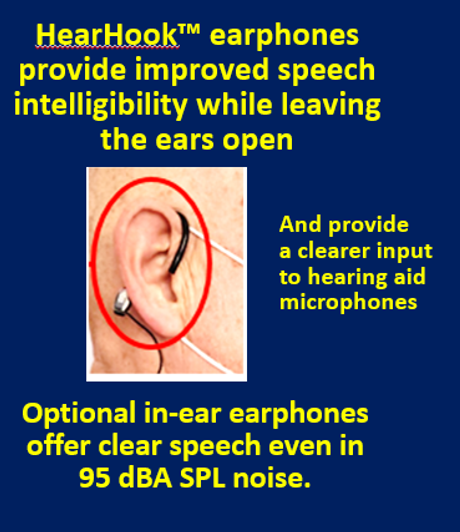Why did we temporarily stop shipping C-Mics when our shelves were full of good products?
By Mead C. Killion, PhD, President MCK Audio, Inc.
Rev 2D
We thought we might solve that “quiet noise” problem by increasing the gain of the microphone preamplifier in the C-Mic circuit, without sacrificing performance on high-level noise inputs. After a few weeks, we obtained the required code, and quick listening checks sounded OK, but the new digital code inexplicably became unstable with the change, and some units would not “stay connected.” Thinking it should be a simple fix, we held off. It turned out it requires a new programming module with a new learning time. It has now been two months since the MCK Audio add appeared in the June issue of Hearing Review.
This week, we decided that we were not – nor should we be – spending all that effort to help listeners hear soft sounds, which they could easily hear with their existing hearing aids. What we were trying to do was help those with and without hearing aids hear in large social gatherings where it was often impossible to understand each other, and where hearing aids can’t help at all or at most with a single Remote Mic. (Indeed, many older digital hearing aids distort so badly at noisy gatherings that their users take them off!)
We expect to have a fully improved CM-4B option soon for evaluation, but in the meantime, the following Update reviews the basic design approach and gives our reasons for starting to ship again a basic circuit unit that has stood the test of time for several years.
More thoughts inspired by this experience:
What is NEW in the C-Mic/HearHook units compared to previous Companion Mics units?
First, our web designer suggested that we shorten the label Companion Mics™ units to C-Mic™ units. We agreed. When we make new labels, we will use the shorter term.
The most important improvement in the product has been the addition of open-ear HearHook™ earphones for use in moderate noise levels, where awareness of surrounding sounds is important, providing an important option to sealed earphones which can, however, provide the maximum intelligibility in high level noise because of their ability to seal external noise arriving at the ear by some 30 dB.

Note: Open-ear HearHook Earphones can also provide a clearer input to hearing aid microphones, which are typically only 10-20 mm away even with BTE units.”
More Background: Moving the microphone closer to the talker’s mouth.
First: The Dream section under About Us in this mckaudio.com website gives the basic story of an encounter with Rocky Stone more than 25 year ago: Holding a hand-held “hearing aid microphone” tightly against my chin allowed him to hear me clearly – despite being profoundly deaf – while I could barely understand him in an industry social gathering. The mouth-to-microphone distance was about 1 inch!
The Rest:
When the first and second generation C-Mics (Companion Mics) units were designed, the design consultants produced a minor miracle in providing good bandwidth, wide dynamic range, and the possibility for four people to hear each other clearly and conversed easily even when they were 3-15 feet from each other (Sort of like a remote mic on steroids!) Three patents resulted.
Just as importantly, these units met the design requirement of undistorted operation with inputs up to 115 dB SPL, for the reasons explained below.
As described in The Banquet Story under Case Studies below, The 80 dBA SPL noise level in Chicago’s Palmer House Ballroom was so high that only the person directly on each side of a listener could be understood. By leaning closer, the talker’s speech at the listener’s ear might have been 85 dB or more, and If the listener has a normal ability to understand speech in noise, the resulting 5 dB speech-to-noise ratio would allow 95% of sentences to be understood.
From six feet across the banquet table, on the other hand, the same talker’s voice would arrive 15 dB weaker (6 feet vs. 1 foot mouth-to-ear distance), and arrive at 70 dB SPL, with zero intelligibility.
Note See the graph below for SENTENCE intelligibility of 95% with 5 dB SNR. I.e. with speech at 85 dB and noise at 80 dB.

The solution – described 25 years ago – was obviously similar to Rocky Stone’s: Pick up my voice near my mouth and then have an adjustable manual or automatic level control to put the output at a comfortable level at his ear.
To continue the explanation: By picking up the voice 6 inches from the talker’s mouth when worn on the collar (or 3 inches from the mouth when worn on a mask), an improvement in signal level of 22 to 28 dB results, compared to the signal arriving from 6 feet away across a banquet table. As described in the Banquet Story, the 80 dBA noise level in that situation was so high that only the person directly on each side of a listener could be understood, and then by leaning closer.
Obviously, the talker’s speech level at the collar-mounted or mask-mounted C-Mic unit would be 102 to 108 dBA, with instantaneous peaks 10 dB higher. That does not cause input distortion because the MEMS microphones in the C-Mic units have a 115 dB undistorted sine-wave input capability.
Neither does it cause discomfort to the C-Mic listeners because they can adjust their volume to their comfort level. As part of the design specifications, the microphone and digital processor in each C-Mic unit had to operate without distortion even with 115 dBA SPL sine wave levels. This is higher than the typical digital hearing aids reported on by Jensen in 2014, as shown in the table below.

Footnote: Comment on the Price of the C-Mic/HearHook units.
The retail price of a complete 4-unit C-Mics™/HearHooks™ system amounts to about $350 per person: Less than one-sixteenth the cost of 4 pairs of traditional hearing aids! Moreover, if a hearing aid wearer carries a set with them, the other three friends can hear clearly in noise unlike anything they have experienced before.
